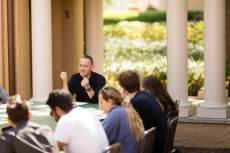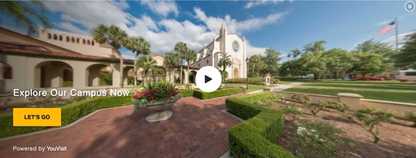What It’s Like ... to Partner with Your Professor
May 04, 2023
By Makayle Kellison ’25 and Maggie Kuffskie ’25, as told to Laura J. Cole ’04 ’08MLS

Thanks to acoustical research they conducted alongside physics professor Whitney Coyle, Makayle Kellison ’25 and Maggie Kuffskie ’25 played a role in the historic launch of the Artemis I rocket.
The Artemis I launch on November 16, 2022, marked NASA’s return to lunar exploration nearly half a century after the conclusion of the Apollo program. Among the closest people to the historic launch were physics majors Makayle Kellison ’25 and Maggie Kuffskie ’25. The duo watched the rocket propel toward space from a dock 11 miles away from the launchpad at Kennedy Space Center (KSC) while collecting data on the impact of its sound with Rollins physics professor Whitney Coyle and a team from Brigham Young University (BYU) led by physics professor Kent Gee.
The research they conducted—which has been published in JASA Express Letters—marks a return to studying the sound levels of rocket launches and their impact on everything from the rocket itself to the launchpad, surrounding communities, and the environment. As part of their research, they set up and calibrated microphones around multiple locations inside and outside KSC, recorded the data, and analyzed the findings alongside the BYU team.
One of the most surprising discoveries the team made was that the sound created by the rocket launch did not travel evenly in all directions, and depending on the orientation of microphones around the rocket, the sound levels changed. For example, someone standing about 20 miles due west of the rocket could barely hear the noise, while 20 miles southwest of the launch pad, it sounded “as loud as 40 million Rice Krispie cereal bowls right after you pour the milk in,” says Kuffskie, referencing her favorite description of the sound level.
Hear from Kellison and Kuffskie in their own words as they share what it’s like to work on this groundbreaking real-world project alongside their professor.

Maggie
Dr. Coyle had been my academic advisor for about a year when she approached me to work on the Artemis project. She knew that I was interested in space and NASA because I had done research with Dr. [Chris] Fuse in the astronomy lab that summer. I was actually at Kennedy Space Center with a friend when she texted me asking if I wanted to be a part of the project.
Makayle
The second time I met with Dr. Coyle, she asked me if I wanted to do research with her, and I have worked with her ever since. Last summer, we did a project through the Student-Faculty Collaborative Scholarship Program researching the musical acoustics of the clarinet. This fall, I did research on the flue organ pipe with [physics professor] Thomas Moore, and I started work on rocket acoustics. They’re all very different types of research—the clarinet research is computational while the organ pipe and rocket research are very hands-on and experimental—which has allowed me to explore different areas of physics and find my niche. My Rollins professors have emphasized that having a well-rounded knowledge of the subject matter and experience in hands-on settings is invaluable for whatever career path I pursue.
Maggie
I am a computer science and physics double major. I enjoy finding meaning in a bunch of numbers. With computational research, I’m guaranteed data. I learned that’s not the case with fieldwork. With Artemis, for example, the launches kept getting scrubbed. We started working with the BYU team in August when the launch was originally scheduled, but it didn’t launch until November 16. Admittedly, it was demoralizing to drive out to KSC at 5 a.m. to set up things and wait excitedly for three days for the launch only to learn two hours before it’s supposed to happen that, nope, you have to do it all again. That was a big lesson in fieldwork—and research in general: It will happen eventually, but you’ve got to keep pushing through.
Makayle
I really appreciate that as students we were in charge. For the first launch attempt in August, I worked with Dr. Moore to set up acoustical measurement stations for Rollins that were specifically placed 20 to 50 miles away from KSC. When I got invited to go to KSC for the November launch, I worked with Dr. Coyle and Dr. Gee to make sure all the microphones were calibrated and the PUMAS [Portable Unit for Measuring Acoustics] were set up correctly. They emphasized us doing it ourselves and taking the lead, which, honestly, is reflected in all of our labs, and I think that’s something that’s very special to Rollins.
Maggie
Being from Florida, I’d watched a couple of launches from Cape Canaveral but never that close and never at night. Makayle, a few students from BYU, and I were stationed on a dock about 11 miles away from the launchpad. It was incredible to be so close and hear the launch and the cheering from the massive crowd on the bridge, and then you see what looked like a second sun show up. It was amazing—and weird—because we all wanted to be cheering and clapping, but we had the sound equipment there, so we were trying not to make much noise.

Makayle
Dr. Coyle and Dr. Gee were about 10 to 20 miles away from us. We were all sending texts, photos, and videos in our group chat. I remember I sent Dr. Coyle the video that I took of the launch, and the next day, she said, ‘It was so cool to watch the video that you sent because in the background, I can just hear your little noises and gasps of astonishment. That made it really special for me.’
Maggie
I loved getting to see a professor I respect be as excited about a project as I was. You get to see this whole other side of your professor when you’re working together on research than you do in the classroom. This project made me feel closer to Dr. Coyle because we have this shared experience. There were nice moments of sitting around just talking and discovering interests we share from science to TV shows. Knowing her more personally, I feel so much more comfortable asking questions in class.
Makayle
What has made this process so valuable is the relationship I’ve developed with Dr. Coyle. Having her as my mentor has been very impactful in finding my place here at Rollins—including becoming a physics major. I can’t believe I’m only in my second year, but by the end of this semester, I will have given three presentations at two different conferences, published two papers with one more in review, and be heading to BYU to spend 10 weeks in the Research Experiences for Undergraduates program funded by the National Science Foundation. Everything that has happened within the past year has completely turned my life around from what it looked like at the end of last year, and none of this would have been possible without Dr. Coyle’s help and support. It makes me very excited for my next two years at Rollins and what's going to come after that.
Maggie
I knew when I came to Rollins that I wanted to major in physics. I was a space nerd and really got into physics my sophomore year of high school. But the reality is, if I wasn’t partnering with my professors on research, I don't think I would be as invested in physics. I would love physics regardless, but the work feels more important because it’s a bigger part of your life. You can point at something you did with someone you admire and say, ‘Hey, we did this thing.’
Makayle
When I step back and think about how much time, money, energy, and people went into this whole project, and then to be able to be a part of that—I was so incredibly lucky. It’s an incomparable experience—and by far one of the best experiences I’ve ever had in my life. Because of Dr. Coyle, I can see myself doing acoustics research as a career, and I would’ve never known that if she hadn't given me these opportunities.

See for Yourself
Get a feel for Rollins’ unique brand of engaged learning and personalized attention through one of our virtual or in-person visit experiences.
Take a Closer LookTake a Closer LookRelated News
June 02, 2025
Morris ’26 Named to 2025 ALL IN Student Voting Honor Roll
Stella Morris ’26 has been named to the 2025 ALL IN Student Voting Honor Roll, a national recognition of student leaders who are driving voter engagement and building a culture of civic participation on college campuses.
May 29, 2025
Rollins Recognized as a Best College for Commuter Students
Designated as a 2025 Best College for Commuters, Rollins is leading the way in building a more accessible, connected, and sustainable campus experience for its commuter students.
May 29, 2025
Rollins Designated a Voter-Friendly Campus
For the fifth time since 2017, Rollins has been named a Voter-Friendly Campus, recognizing the College’s deep commitment to empowering student voters and strengthening civic participation.


